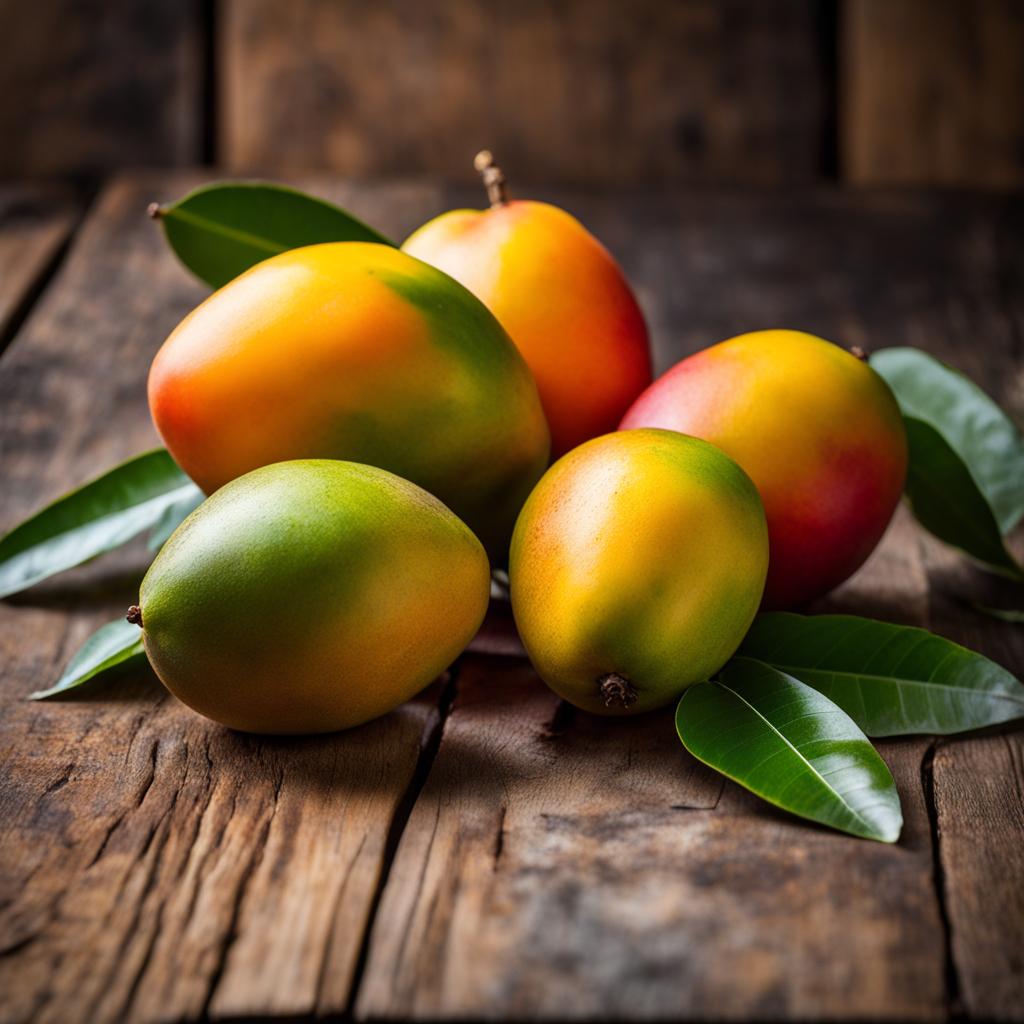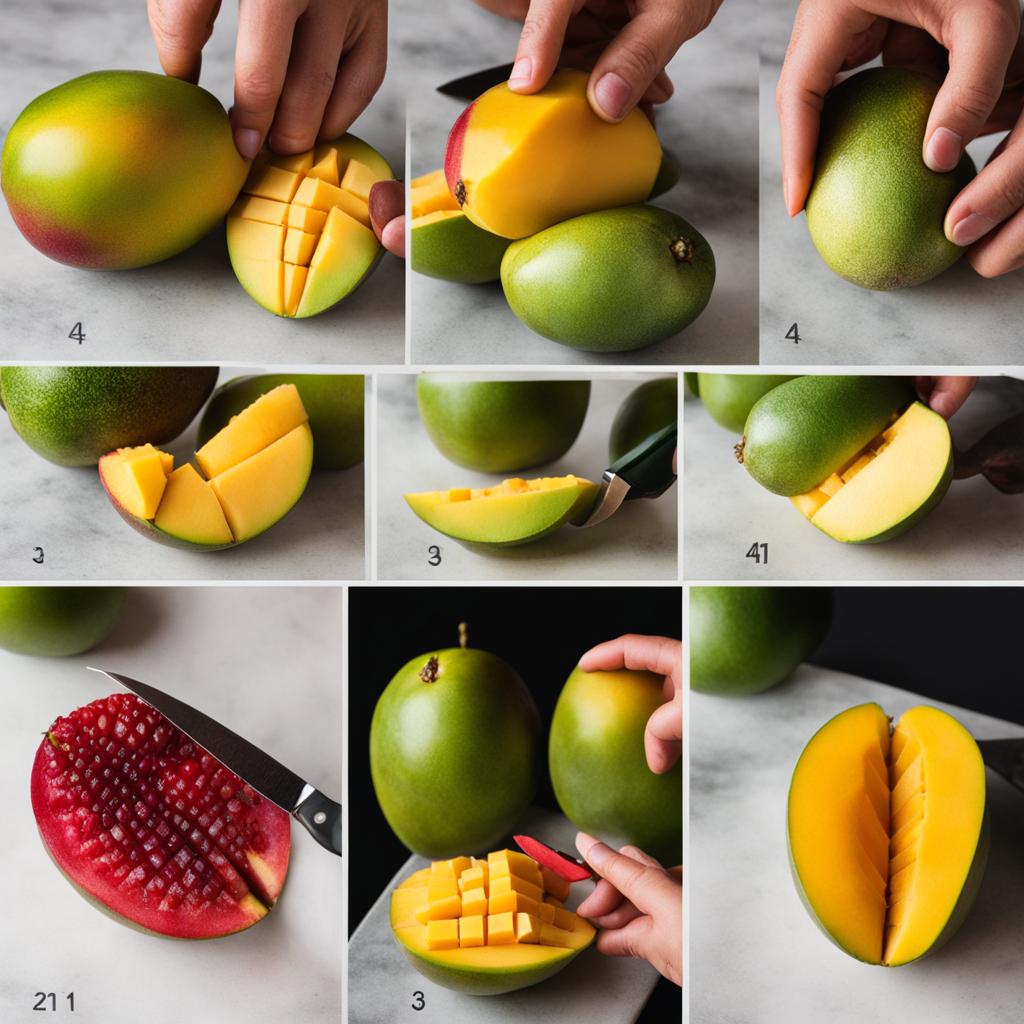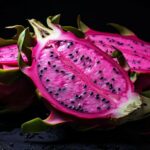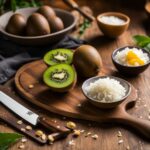Are you tired of biting into unripe or overripe mangoes? In this article, I will guide you on how to tell if a mango is ripe and ready to be enjoyed. By understanding the various indicators of mango ripeness and using expert tips, you’ll never have to guess again!
Key Takeaways:
- Learning how to determine mango ripeness can help you select the perfect fruit for your enjoyment.
- Assess the firmness and texture of the mango to ensure it’s neither too hard nor too soft.
- Check for a pleasant fruity aroma, indicating that the mango is ripe.
- Consider the weight of the mango, as ripe ones tend to be heavier.
- Observe the skin texture and color, looking for smoothness and absence of wrinkles.
Understanding Mango Varieties
Mangoes are a delicious tropical fruit that comes in a variety of types, each with its own unique characteristics. When it comes to determining the ripeness of a mango, it’s important to consider the specific attributes of the mango variety you are dealing with. While the color of a mango may be an indicator of ripeness for some varieties, it’s not always the case for all. Let’s explore the different mango varieties and learn how to identify their ripeness based on their specific attributes.
Types of Mangoes
There are numerous types of mangoes available in the market, each originating from different parts of the world. Some popular mango varieties include:
- Alphonso: Originating from India, Alphonso mangoes are known for their sweet and creamy flavor.
- Ataulfo: Also known as the honey mango, Ataulfo mangoes have a rich and buttery taste.
- Kent: Kent mangoes have a juicy and sweet flavor, with a slightly fibrous texture.
- Tommy Atkins: Tommy Atkins mangoes are widely available and have a mild and sweet flavor.
These are just a few examples of the many mango varieties out there. Each variety has its own distinct taste, texture, and color, making it important to familiarize yourself with the specific characteristics of the mangoes you encounter.
Mango Colors
The color of a mango can vary depending on its variety and ripeness. While some mango varieties turn a vibrant shade of orange or red when ripe, others may remain green, even when fully ripe. It’s essential to know the typical color characteristics of the mango variety you are dealing with.
| Mango Variety | Ripeness Indicator | Color | Flavor |
|---|---|---|---|
| Alphonso | Firmness, aroma | Yellow to orange | Sweet and creamy |
| Ataulfo | Firmness, aroma | Golden yellow | Rich and buttery |
| Kent | Firmness, color | Green to yellow | Juicy and sweet |
| Tommy Atkins | Firmness, color | Green to red | Mild and sweet |
Table: Mango Varieties and Their Attributes
As shown in the table above, different mango varieties have their own unique ripeness indicators, flavors, and colors. By understanding these characteristics, you can confidently determine the ripeness of the mangoes you encounter and select the perfect one for your enjoyment.
Assessing Firmness and Texture
When it comes to determining the ripeness of a mango, assessing its firmness and texture is key. A ripe mango should have a specific feel when gently squeezed. If it feels rock-hard, then it is likely unripe and needs more time to ripen. On the other hand, if the mango feels overly soft or mushy, it may be overripe.
The ideal texture of a ripe mango should be soft and smooth, without any signs of mushiness or stringiness. You want the flesh to be tender and juicy, with a melt-in-your-mouth quality. To assess the texture, gently squeeze the mango using your fingertips. It should have a slight give without being too firm or too soft.
Remember that different varieties of mangoes may have slight variations in firmness and texture, so it’s important to familiarize yourself with the specific attributes of the variety you are working with. By understanding the ideal firmness and texture of the mango you are looking for, you can confidently determine if a mango is ripe and ready to be enjoyed.
Checking for Aroma
One of the key indicators of a ripe mango is its aroma. A ripe mango will have a enticing fruity smell that is hard to resist. To check for this aroma, simply bring the stem end of the mango close to your nose and take a gentle sniff. If you detect a sweet and fragrant smell, it is a good sign that the mango is ripe and ready to be enjoyed. The fruity aroma is a result of the natural sugars in the mango developing as it reaches its peak ripeness.
However, it’s important to note that not all mangoes have a strong aroma, especially certain varieties. Some mangoes may have a milder scent or even no aroma at all. In these cases, it’s best to rely on other indicators of ripeness such as firmness and texture. The aroma test is most effective when combined with other methods to ensure accuracy.
“The sweet and fragrant smell of a ripe mango is like a tropical paradise in your kitchen.” – Expert Mango Taster
Table: Mango Aromas by Variety
| Variety | Aroma |
|---|---|
| Alphonso | Strong and fragrant |
| Kent | Mild and sweet |
| Ataulfo | Faint tropical scent |
| Honey Mango | Intense honey-like aroma |
As shown in the table above, different mango varieties can have varying levels of aroma. Some varieties, like the Alphonso and Honey Mango, have strong and distinct aromas, while others, like the Ataulfo, have a milder scent. Familiarize yourself with the aromas associated with the mango varieties you prefer to ensure you can identify the ripest and most flavorful options.
Assessing Weight
Another important indicator of mango ripeness is its weight. A ripe mango will generally feel heavier compared to an unripe one. When selecting mangoes at the store, I recommend choosing ones that are heavier as they are likely more ripe and ready to eat. The heaviness is a result of the mango’s juice content, which increases as the fruit ripens.
To assess the weight of a mango, simply hold it in your hand and compare it to other mangoes of similar size. A ripe mango will feel substantial and have a satisfying weight to it. It should not feel light or hollow, as this may indicate that the mango is not yet fully ripe. Keep in mind that the weight of a mango can vary depending on its size and variety, so it’s essential to develop a sense of what feels right for each type of mango.
| Mango Variety | Average Weight (oz) |
|---|---|
| Alphonso | 8-12 |
| Ataulfo | 5-7 |
| Haden | 13-16 |
| Kent | 18-22 |
Here is a table that provides average weights for popular mango varieties. Use this as a general guide, but remember that individual mangoes can still vary in weight. By considering both the weight and other indicators of mango ripeness, such as firmness and aroma, you can confidently select the perfect ripe mango for your enjoyment.
Remember: A heavier mango is more likely to be ripe and juicy.
Observing Skin Texture and Color
When determining the ripeness of a mango, the texture and color of the skin can provide valuable clues. A ripe mango will have smooth skin without any wrinkles or blemishes. Take a close look at the mango and run your fingers over its surface. If you feel any rough patches or indentations, it may indicate that the mango is not quite ripe yet.
The color of the mango’s skin can vary depending on the variety, so it’s important to know the specific color characteristics of the mango you are selecting. For example, some mango varieties will have a vibrant red or orange color when ripe, while others may have a more subtle yellow or green hue. Familiarize yourself with the expected color range of the mango variety you are choosing, and look for a consistent, uniform color across the entire surface of the fruit.
Remember that the skin color alone is not always a reliable indicator of ripeness, as some mangoes can have different colors even when ripe. It’s best to combine color observation with other ripeness indicators, such as firmness and aroma, to ensure the mango is truly ripe and ready to be enjoyed.
| Mango Variety | Skin Color when Ripe |
|---|---|
| Alphonso | Pale yellow with hints of orange |
| Ataulfo | Bright yellow |
| Kent | Dark green with red or yellow blush |
| Haden | Red and green |
Using the Squeeze Test
One popular method for determining the ripeness of a mango is the squeeze test. By gently squeezing the mango, you can assess its firmness and determine if it is ripe enough to enjoy.
When performing the squeeze test, it’s important to feel for a slight give in the mango. A ripe mango will have a little bit of softness when squeezed, indicating that it is ready to be eaten. However, if the mango feels too firm or unyielding, it may be unripe and not yet at its peak ripeness.
On the other hand, if the mango feels excessively soft or mushy when squeezed, it may be overripe. Overripe mangoes can have a pulpy texture and may not taste as desirable as ripe mangoes. The ideal ripe mango will have a slight give without being too soft or mushy.
Benefits of the Squeeze Test:
- Easy and convenient method
- Provides immediate feedback on mango ripeness
- Can be done while shopping or at home
“Using the squeeze test is a simple and effective way to determine the ripeness of a mango. By paying attention to the firmness of the fruit when gently squeezed, you can ensure that you’ll be enjoying a perfectly ripe mango every time.” – Mango lover
The Sap Burn Indicator
When it comes to determining the ripeness of a mango, one reliable indicator is the presence of sap burn. Mangoes naturally produce sap when they are ripe, and this can result in dark spots or lines near the tip of the fruit. The sap burn is a clear visual signal that the mango is ripe and ready to be enjoyed.
The sap burn indicator is especially useful when other indicators, such as firmness or color, may not be as reliable. By looking for these dark spots or lines on the mango, you can quickly assess its ripeness without the need for additional tests or guesswork.
“The sap burn is a clear visual signal that the mango is ripe and ready to be enjoyed.”
When selecting a mango with sap burn, it’s important to ensure that the dark spots or lines are not excessive or indicate spoilage. A few small spots or lines are normal and a sign of ripeness, but if the mango has extensive sap burn or shows signs of mold or decay, it may be best to choose another fruit.
| Sap Burn Indicator | Interpretation |
|---|---|
| Dark spots or lines near the tip of the mango | Indicates ripeness |
| Excessive sap burn or signs of spoilage | Choose another fruit |
By understanding and utilizing the sap burn indicator, you can confidently select ripe mangoes that are at their peak of flavor. Whether you plan to eat the mango as is or use it in your favorite recipes, the presence of sap burn is a sure sign that you’re in for a delicious treat.

Allowing for Natural Ripening
When it comes to ripening mangoes, sometimes nature knows best. If you have unripe mangoes, you can simply leave them at room temperature to allow them to ripen naturally. Avoid refrigerating unripe mangoes, as the cold temperature can slow down the ripening process. By allowing the mangoes to ripen naturally, you can ensure that they reach their peak flavor and sweetness.
To speed up the ripening process, there are a few tricks you can try. One method is to wrap the mangoes in a towel or place them in a paper bag. This helps to trap the natural gases that the mangoes release as they ripen, creating a more concentrated environment that speeds up the process. Check on the mangoes daily to monitor their ripeness and adjust the time as needed.
It’s important to note that not all mangoes will ripen at the same rate. Some may take a few days, while others may take up to a week or more. Patience is key when allowing mangoes to ripen naturally, but the delicious results are definitely worth the wait. So sit back, relax, and let nature work its magic on your mangoes.
Table: Ripening Time for Different Mango Varieties
| Variety | Ripening Time |
|---|---|
| Alphonso | 2-4 days |
| Ataulfo | 3-5 days |
| Kent | 4-6 days |
| Tommy Atkins | 5-7 days |
The ripening time for mangoes can vary depending on the variety. The table above provides a general guide to the ripening time for some popular mango varieties. However, it’s important to remember that these times are approximate and can vary based on factors such as the mango’s maturity when purchased and the ambient temperature.
Enjoying Ripe Mangoes
Once you have determined that a mango is ripe, there are numerous delicious ways to enjoy it. Ripe mangoes can be used in a variety of recipes, from salads to smoothies to mouthwatering desserts. Here are some ideas to get you started:
Mango Salsa:
Add a tropical twist to your favorite salsa recipe by incorporating juicy mangoes. Combine diced ripe mangoes with tomatoes, onions, jalapenos, cilantro, and lime juice for a refreshing and flavorful salsa. Serve it with tortilla chips or use it as a topping for grilled fish or chicken.
Mango Smoothie:
Blend ripe mangoes with yogurt, milk, and a touch of honey for a creamy and refreshing smoothie. You can also add other fruits like banana or pineapple for extra flavor. Enjoy it as a quick and nutritious breakfast or a refreshing snack on a hot day.
Mango Sorbet:
Beat the heat with a homemade mango sorbet. Puree ripe mangoes with sugar and lemon juice, then freeze the mixture until firm. The result is a smooth and creamy sorbet with the perfect balance of sweetness and tanginess. Serve it as a dessert on its own or use it to garnish other sweet treats.
These are just a few examples of the many ways you can enjoy ripe mangoes. Get creative in the kitchen and explore different recipes to fully savor the deliciousness of this tropical fruit.
| Dessert | Ingredients | Preparation Time |
|---|---|---|
| Mango Cheesecake | Cream cheese, graham crackers, ripe mangoes, sugar, butter, vanilla extract, eggs | 1 hour 30 minutes |
| Mango Sticky Rice | Glutinous rice, ripe mangoes, coconut milk, sugar, salt | 1 hour |
| Mango Panna Cotta | Heavy cream, ripe mangoes, sugar, gelatin, vanilla extract | 4 hours |
Storing Ripe Mangoes
Once you have determined that a mango is ripe and ready to be enjoyed, it’s important to store it properly to maintain its freshness. Storing ripe mangoes correctly will help extend their shelf life and prevent them from spoiling too quickly. Here are some tips on how to store ripe mangoes:
- Refrigerate: If you have ripe mangoes that you’re not ready to eat immediately, it’s best to store them in the refrigerator. Placing the mangoes in the fridge will slow down the ripening process and help them stay fresh for longer.
- Use a Storage Container: To prevent the ripe mangoes from getting squished or bruised, place them in a storage container or a plastic bag before placing them in the refrigerator. This will help protect their delicate flesh and maintain their quality.
- Avoid Moisture: Make sure the storage container or bag is dry before placing the ripe mangoes in it. Excess moisture can cause the mangoes to spoil quickly, so it’s important to keep them dry throughout their storage.
- Separate from Ethylene-Producing Fruits: Mangoes produce ethylene gas, which can speed up the ripening process of other fruits. To prevent overripening, store ripe mangoes away from other ethylene-producing fruits such as apples, bananas, and avocados.
By following these storage tips, you can keep your ripe mangoes fresh and delicious for up to five days in the refrigerator. If you’re not able to consume the ripe mangoes within that timeframe, you can also freeze them for later use.
Table: Storage Tips for Ripe Mangoes
| Storage Method | Duration |
|---|---|
| Refrigeration | Up to 5 days |
| Freezing (Peeled and Cubed) | Up to 6 months |
Freezing ripe mangoes is a great way to preserve their sweet and juicy flavor for an extended period. To freeze ripe mangoes, simply peel and cube them, then place the cubes in an airtight container or freezer bag. Label the container with the date and store it in the freezer until you’re ready to use the frozen mangoes in smoothies, desserts, or other recipes.
Now that you know how to store ripe mangoes properly, you can enjoy their tropical goodness for longer and savor them in various dishes. Whether you prefer to eat ripe mangoes fresh or use them in your favorite recipes, proper storage will help preserve their flavor and texture, allowing you to enjoy them at their best.
Learning How to Cut a Mango
Now that you have determined that a mango is ripe and ready to be enjoyed, it’s time to learn how to cut it properly. Cutting a mango may seem daunting, but with the right technique, you can easily slice through the juicy flesh and create beautiful mango pieces. Follow these steps to master the art of mango cutting:
- Start by placing the mango on a cutting board, stem end facing up.
- Using a sharp knife, make a vertical cut along one side of the mango, following the shape of the pit.
- Repeat step 2 on the other side of the mango, creating two mango halves.
- Hold one mango half in your hand, skin side down. Make lengthwise and crosswise cuts into the mango flesh, being careful not to cut through the skin.
- Gently push the mango half inside out, so the cut mango cubes pop up.
- Repeat steps 4 and 5 with the other mango half.
- If desired, you can also remove any remaining flesh from the mango pit by carefully cutting it away.
Now you have perfectly cut mango cubes that are ready to be added to your favorite dishes or enjoyed on their own. Take a moment to appreciate the vibrant colors and sweet aroma of the freshly-cut mango, and savor each juicy bite.
“Cutting a mango can be intimidating at first, but with practice, it becomes second nature. Remember to use a sharp knife for clean cuts and be cautious of the mango pit. Once you’ve mastered the technique, you’ll be able to enjoy the delicious taste of fresh mango whenever you desire.” – Expert Mango Enthusiast
It’s important to note that there are alternate cutting techniques, such as creating a grid pattern or using a mango slicer, that may suit your preferences and needs. Explore different methods and find the one that works best for you. With time and practice, you’ll become a pro at cutting mangoes and impress your friends and family with your culinary skills.
Table: Mango Cutting Techniques Comparison
| Technique | Description | Advantages | Disadvantages |
|---|---|---|---|
| Vertical Slices | Making lengthwise cuts on each side of the mango | Provides mango slices that can easily be enjoyed | Leaves behind the pit, which can be challenging to extract all the flesh from |
| Grid Pattern | Cutting vertical and horizontal lines into the mango flesh | Creates neat and even mango cubes | Requires more precision and can be time-consuming |
| Mango Slicer | Using a specialized tool designed to slice through the mango | Efficient and easy to use | May not be suitable for all mango sizes and varieties |

Experiment with these different techniques to find the one that suits your preference. Each method offers its own unique advantages and can be used to create beautiful presentations with mangoes. Remember, practice makes perfect, so don’t be discouraged if your first attempts aren’t flawless. As you continue to cut mangoes, you’ll gain confidence and improve your skills.
The Versatility of Mangos
Mangos are a truly versatile fruit that can be used in a wide range of recipes. Whether you’re looking to create a savory dish, a refreshing beverage, or a delectable dessert, mangos are sure to add a burst of tropical flavor to your culinary creations.
One of the simplest ways to enjoy mangos is by incorporating them into salads. Their natural sweetness pairs beautifully with fresh greens and tangy dressings, creating a delightful balance of flavors. Try combining sliced mangos with arugula, goat cheese, and a zesty vinaigrette for a refreshing and satisfying salad.
Mangos are also a fantastic addition to salsas. Their juicy texture and vibrant taste complement the other ingredients, adding a tropical twist to the classic condiment. Create a mango salsa by combining diced mangos with red onion, jalapeno, cilantro, lime juice, and a pinch of salt. Serve it alongside grilled fish or chicken for a burst of flavor.
| Recipe | Description |
|---|---|
| Mango Smoothie Bowl | A refreshing and nutritious breakfast option, a mango smoothie bowl is a thick and creamy blend of mangoes, yogurt, and your choice of toppings such as granola, coconut flakes, and fresh berries. |
| Mango Curry | A rich and aromatic curry made with ripe mangos, coconut milk, and spices. This dish combines sweet and savory flavors, resulting in a satisfying and comforting meal. |
| Mango Sorbet | A light and refreshing dessert made with pureed mangos, sugar, and lemon juice. Enjoy it on a hot summer day or as a sweet ending to a meal. |
“Mangos are a true gift of nature. Their versatility allows them to shine in both savory and sweet dishes, adding a tropical touch to any recipe. From tangy salsas to creamy smoothies, mangos are the perfect ingredient for those who love to experiment in the kitchen.” – Chef Emily Thompson
With their delightful flavor and vibrant color, mangos can also be used to create a wide range of desserts. From pies and cakes to ice creams and sorbets, the possibilities are endless. Indulge in a refreshing mango sorbet, savor a slice of mango cheesecake, or treat yourself to a scoop of mango ice cream for a truly tropical dessert experience.
The versatility of mangos extends beyond the kitchen. Their tangy sweetness can also be enjoyed in beverages such as smoothies and cocktails. Blend ripe mangos with your favorite fruits, yogurt, and ice for a refreshing smoothie, or muddle them with fresh herbs and spirits for a tropical cocktail that will transport you to a beachside paradise.
Whether you’re cooking up a savory meal, whipping up a delicious dessert, or simply enjoying a fresh mango on its own, this versatile fruit is sure to bring a taste of the tropics to your table. Embrace the versatility of mangos and let your culinary creativity soar!
Embracing the Joy of Mangoes
As a mango enthusiast, I can’t help but feel an overwhelming sense of joy whenever I bite into a perfectly ripe mango. The sweet juiciness, the vibrant colors, and the tropical aroma all combine to create a truly delightful experience. Mango appreciation is something that can be shared by people from all walks of life, as this delicious fruit has a way of bringing people together.
Mangoes have a rich history and cultural significance in many countries, making them even more special. Whether it’s enjoying a traditional mango lassi in India or savoring a mango sticky rice dessert in Thailand, mangoes have the power to transport our taste buds to exotic destinations. The love for mangoes is universal, as they are not only delicious but also incredibly versatile in the kitchen.
“Mangoes are nature’s way of showing us that joy can come in the simplest and sweetest forms.”
The love for mangoes goes beyond their taste and culinary uses. This fruit is also packed with health benefits, making it a wise choice for those looking to enhance their well-being. Mangoes are a good source of vitamins, minerals, and antioxidants, which can support a healthy immune system and promote overall vitality.
Conclusion
In conclusion, determining the ripeness of a mango may initially seem daunting, but with the knowledge and techniques shared in this article, you can easily become an expert mango connoisseur. By relying on your senses of touch, smell, and sight, you can confidently assess the ripeness of a mango and indulge in its sweet, juicy flavor.
Remember, when selecting a ripe mango, consider its firmness, texture, aroma, weight, and skin characteristics. A ripe mango should give slightly when gently squeezed, have a pleasant fruity aroma, feel heavier than an unripe one, and have smooth, blemish-free skin. You can also look out for the sap burn near the tip of the mango as a reliable indicator of ripeness.
Once you’ve identified a ripe mango, the culinary possibilities are endless. From savory dishes to refreshing drinks and delectable desserts, ripe mangoes can add a tropical touch to your favorite recipes. And if you have ripe mangoes you’re not ready to eat immediately, remember to store them properly in the refrigerator or freeze them for later use.
So, embrace the joy of mangoes and let the sweet and luscious taste transport you to a tropical paradise. With practice and experience, your love for mangoes will only grow, and you’ll be able to savor and appreciate the ripest mangoes with confidence.
FAQ
How can I tell if a mango is ripe?
To determine the ripeness of a mango, you can assess its firmness and texture, check for a pleasant aroma at the stem end, consider its weight, observe the skin texture and color, use the squeeze test, and look for sap burn near the tip of the mango.
What is the best way to store ripe mangoes?
Ripe mangoes can be stored in the refrigerator for up to five days to slow down the ripening process. Alternatively, you can peel and cube the mangoes, then freeze them for up to six months.
How do I cut a mango properly?
There are various techniques for cutting a mango, such as making vertical slices or creating a grid pattern. Find a method that works best for you and enjoy the fruit!
What can I make with ripe mangoes?
Ripe mangoes are versatile and can be used in salads, salsas, smoothies, desserts, and more. They add a burst of tropical flavor to any culinary creation.
Why should I embrace the joy of mangoes?
Mangoes are a delightful fruit that brings joy to many people. Learning how to determine their ripeness allows you to fully appreciate their sweet and juicy flavor, adding a refreshing touch to your favorite dishes.
Source Links
- https://www.allrecipes.com/how-to-tell-if-your-mango-is-ripe-7564460
- https://carlsbadcravings.com/how-to-cut-a-mango/
- https://www.mango.org/choose-a-mango/
Related Recipes:
 Picking the Perfect Dragon Fruit: Ripe Signs
Picking the Perfect Dragon Fruit: Ripe Signs
 Identifying Ripe Bananas: A Quick Guide
Identifying Ripe Bananas: A Quick Guide
 How to Cut Dragon Fruit? (Perfect Step-By-Step Guide)
How to Cut Dragon Fruit? (Perfect Step-By-Step Guide)
 Signs of a Ripe Cantaloupe
Signs of a Ripe Cantaloupe
 How to Freeze Passion Fruit? (Step-By-Step Guide)
How to Freeze Passion Fruit? (Step-By-Step Guide)
 How to Make Candied Fruit (Easy Step-by-Step Guide)
How to Make Candied Fruit (Easy Step-by-Step Guide)
 How to Store Kiwi for Peak Ripeness
How to Store Kiwi for Peak Ripeness
 How to Store Bananas for Extended Ripeness
How to Store Bananas for Extended Ripeness








